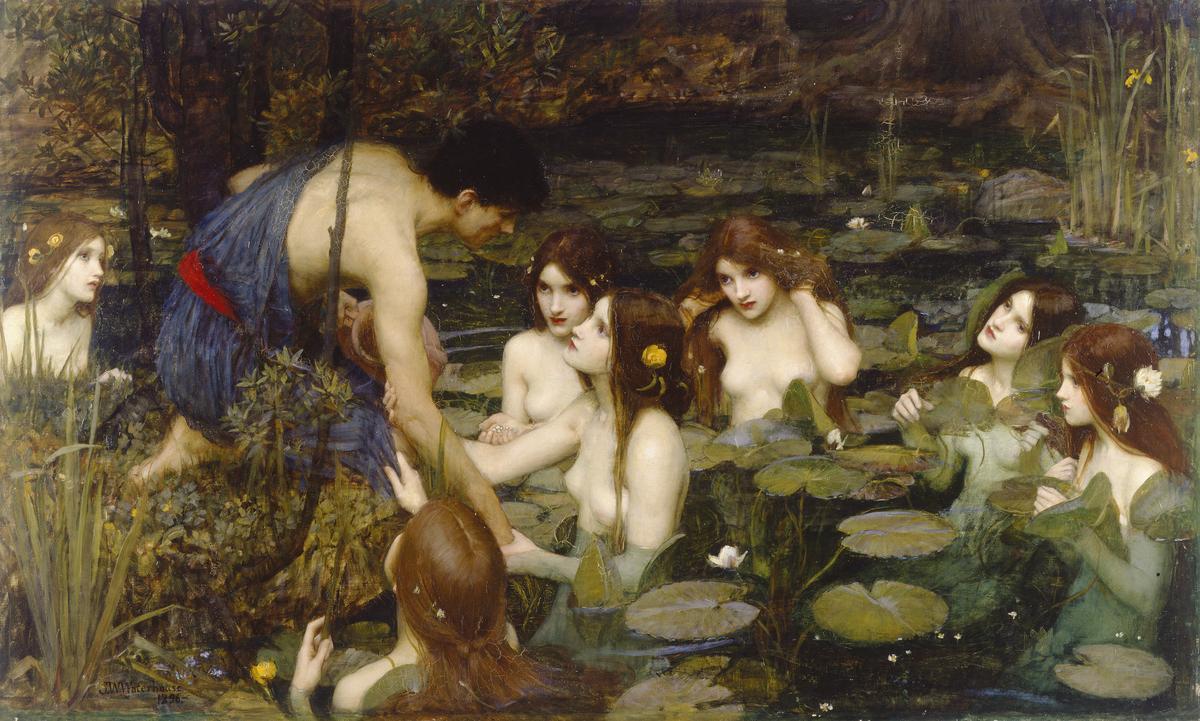With a Manchester gallery removing an ‘objectifying’ painting, why are we in such a hurry to erase the past?
There’s something wrong with a culture that refuses to allow itself to be shocked, that denies arousal, that rejects beauty in favour of politics


A young man contemplates a dip with a bunch of nubile young women, who look teasingly and temptingly at his lithe muscular body; one has already grabbed his arm, another pulls at his clothes. The setting is a dark wood, damp with waterlily pads and yellow irises, a green limpid pool against which the women’s bodies seem unnaturally pale. They all have the same slightly chilling look.
Another ludicrous male fantasy that should justly be consigned to oblivion? John William Waterhouse’s Hylas and the Nymphs, painted in 1896, was removed from display in Manchester Art Gallery in order to provoke a debate about the objectification of women. As a ruse it’s worked. There is definitely a debate, mostly condemnatory, and the painting has now been put back on display following instructions from the city council, who are ultimately responsible for the gallery.
Was this whole affair just a publicity stunt or was it actually an attempt to justify censorship on the part of the gallery’s curators? An interview with the curator responsible, Clare Gannaway, betrays an attitude towards the painting and the artistic movement Waterhouse was part of, Aestheticism, which is bizarrely and ironically Victorian in its moral probity.
Waterhouse was a phenomenal user of paint and extremely popular with the gallery going public – his Lady of Shallott in Tate Britain is among the nation’s favourites – and Hylas is an exquisitely beautiful work dripping with wetness and seduction and, yes, objectification. From that perspective it’s difficult to look at and was so in his time. But that was the point. He set out to embarrass the viewer with all those pert breasts and come-hitherness into recognising that sexual fantasy could also be beautiful.
Aestheticism, which emerged in art and literature in the latter part of the 19th century, was far more troubling and challenging than the twee arts and crafts version we seem to have inherited. The notion of art for art’s sake it espoused jettisoned any moral content or purpose in favour of a purely aesthetic response, the “Pursuit of Beauty” Gannaway mistakenly so objects to. Art could be about sex and sexuality, and the more forbidden the better. It was The Picture of Dorian Gray and Salome, sadomasochism and opium, and yes, Hylas and his nymphs.
And yet there’s an understanding about Aestheticism – recognition of its absurdity, its over-the-top nature, if you like, that allows us, the audience, to collude in the fantasy without getting our hands dirty. The irony with Waterhouse’s painting is that in Greek mythology Hylas was the lover of the hero Herakles (or Hercules), dragged to a watery death by the equivalent of a horde of female fans. Herakles then spends years vainly looking for him while the beautiful boy’s grown fat and middle-aged and heterosexual at the bottom of the pool, which is a bit like death, I suppose.
Whatever stunt the curators of the Manchester Art Gallery were pulling, there is a more serious point behind this which appeared to be questioning the validity of art made in the past that, we’re told, doesn’t chime with modern notions of morality. It’s the wrong question and the wrong approach.
Must we throw out all art that explores and exploits sexuality? Is this what the new puritans are demanding? Titian’s flagrant nudes, Modigliani’s prominent pudenda, must go then. Salome, both the play by Oscar Wilde and the opera by Richard Strauss, deals with a frustrated homicidal young girl, a much more disturbing view of female sexuality than Waterhouse’s painting, in an exquisitely beautiful way. Should it be banished from the stage? Mozart’s Don Giovanni, Bizet’s Carmen have been criticised for related reasons.
Why stop at the depiction of women? Michelangelo’s nudes on the Sistine Chapel ceiling are equally gratuitous totty for the male gaze, this time on young male flesh. The Catholic Church has worried about them ever since: whitewash them, surely, it’s the only way?
The Manchester Art Gallery’s provocation was supposed to go to the heart of the debate about the exploitation of women, a debate we have to continue, but which actions like this merely deflect from, which is presumably why the painting is back on display. Its reporting came just as the bosses of Formula 1 announced the demise of the “Grid Girls” – those preternaturally pretty young women who hang around the pit stop. As they have no function other than to be demeaned, it’s good riddance (and I hope they can find a better job). But is Waterhouse, and all the other artists and artworks I’ve suggested inhabit a similar world, really part of this? Unlike Grid Girls, unlike pornography, no one is seemingly harmed by a painting.
The gallery is on tricky ground. Was it censoring Waterhouse’s painting? Gannaway says no, but how else do you describe the removal of an artwork because someone objects to its subject matter on the grounds of a debate that actually has nothing to do with it? Perhaps a little sensitivity training for the staff of the gallery might be in order.
There’s something wrong with a culture that refuses to allow itself to be shocked, that denies arousal, that rejects beauty in favour of politics. In this way the debate about the objectification of women is in danger of becoming merely reactionary. “The beauty of art, like tears shed at a play, gives no pain”, wrote the critic Johann Joachim Winckelmann. What the new puritans did in Manchester is forget that we need our nymphs and Salomes and Don Juans, for that matter; they provide a safe space in which to indulge our darkest fantasies and thereby help us behave better; and yes, we need that poor boy who was just looking for a drink and fell in with a crowd of teenage girls.
Kevin Childs is a writer and lecturer on art history and the history of visual culture




Join our commenting forum
Join thought-provoking conversations, follow other Independent readers and see their replies